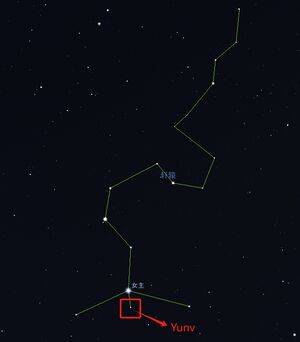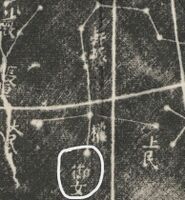Yunü: Difference between revisions
No edit summary |
(Name suggestion added) |
||
| Line 3: | Line 3: | ||
{{DISPLAYTITLE:Yunv (御女)}} |
{{DISPLAYTITLE:Yunv (御女)}} |
||
== Etymology & History of the term == |
== Etymology & History of the term == |
||
According to ancient Chinese astrological theory, the Xuanyuan constellation represents the group of imperial consorts. In this context, 31 Leo was given different meanings by various astrological schools. The Huangdi school, for instance, believed this star represented the son born to the empress ( |
According to ancient Chinese astrological theory, the Xuanyuan constellation represents the group of imperial consorts. In this context, 31 Leo was given different meanings by various astrological schools. The Huangdi school, for instance, believed this star represented the son born to the empress (alf Leo), while other scholars such as Shi School and Jiao Yanshou identified it as Nvyu<ref>Qutan Xida. Kaiyuanzhanjing 开元占经. Beijing: Jiuzhou Press, 2012:643-644.</ref>, indicating a lower-ranking concubine of the emperor. The latter meaning became popular later. Before the Tang dynasty, this star was consistently referred to as Nvyu. However, after the Song dynasty, the term Yunv became more prevalent. |
||
The two terms "Nvyu" and "Yunv" have the same meaning, with the order of the two syllables being reversed. |
|||
== Images == |
== Images == |
||
| Line 10: | Line 12: | ||
File:Yunv on the Qing Dynasty Star Chart.jpg|Yunv on the Qing Dynasty Star Chart |
File:Yunv on the Qing Dynasty Star Chart.jpg|Yunv on the Qing Dynasty Star Chart |
||
</gallery> |
</gallery> |
||
== IAU WGSN - Star Name Discussion == |
|||
In 2024 the name was suggested to the WGSN. For the use in English language (research papers in astrophysics), we prefer the variant "Yunv" for [https://simbad.cds.unistra.fr/simbad/sim-id?Ident=31+Leo&NbIdent=1&Radius=2&Radius.unit=arcmin&submit=submit+id 31 Leo (SIMBAD)]. This star is a high proper motion-star with a visual magnitude of 4.38 mag. The spectral class K3 describes its reddish/ orange colour. |
|||
== References == |
== References == |
||
* general list of References |
|||
* general list of [[References (Chinese)|Chinese References]] |
|||
[[Category:Single star-asterism]] |
[[Category:Single star-asterism]] |
||
Revision as of 14:18, 11 July 2024
Yunv御女 is the star in the middle of the southernmost stars of the Xuanyuan轩辕 constellation.
Etymology & History of the term
According to ancient Chinese astrological theory, the Xuanyuan constellation represents the group of imperial consorts. In this context, 31 Leo was given different meanings by various astrological schools. The Huangdi school, for instance, believed this star represented the son born to the empress (alf Leo), while other scholars such as Shi School and Jiao Yanshou identified it as Nvyu[1], indicating a lower-ranking concubine of the emperor. The latter meaning became popular later. Before the Tang dynasty, this star was consistently referred to as Nvyu. However, after the Song dynasty, the term Yunv became more prevalent.
The two terms "Nvyu" and "Yunv" have the same meaning, with the order of the two syllables being reversed.
Images
- Yunv
IAU WGSN - Star Name Discussion
In 2024 the name was suggested to the WGSN. For the use in English language (research papers in astrophysics), we prefer the variant "Yunv" for 31 Leo (SIMBAD). This star is a high proper motion-star with a visual magnitude of 4.38 mag. The spectral class K3 describes its reddish/ orange colour.
References
- general list of References
- general list of Chinese References
- ↑ Qutan Xida. Kaiyuanzhanjing 开元占经. Beijing: Jiuzhou Press, 2012:643-644.







